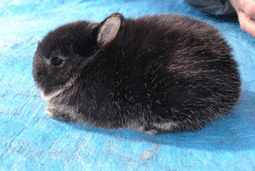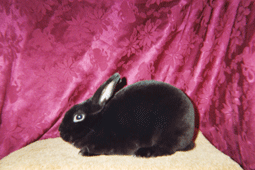Hip-Hoppity Lady
Air Date: Week of April 14, 2006

One of Laura’s “hoppers” (Courtesy of Laura McKenzie)
Easter time means bunnies. Lots of them. The demand for rabbits has business booming. Nina Mitchell profiles one successful bunny business lady.
Transcript
CURWOOD: According to the American Pet Products Manufacturers Association, there are nearly seven million pet rabbits in the United States. And around Easter time, the demand for the fluffy critters starts hoppin’. Nina Mitchell visited one breeder to learn the ins and outs of raising rabbits.
MITCHELL: In a modest beige house on a crowded little street in Watertown, Massachusetts, lives Laura McKenzie, the Rabbit Lady.
McKENZIE: If I go into public places and people know my daughter, the parents will say, “There’s the Rabbit Lady.” And I just want to cringe when I hear that. Now I’ve gotten used to it, so now I just accept it.
MITCHELL: It all began 11 years ago, when Laura’s husband, John, wanted a pet.
JOHN McKENZIE: I just wanted one rabbit! (Laughs)
MITCHELL: Now they have 37.
[RABBIT SOUNDS]
MITCHELL: That’s Betsy. Betsy looks like she has rabbit highlights. Her fur is fiery red-brown with the occasional darker stripes. Rabbits are usually quiet animals, but when they’re pregnant, they make noises burrowing in their cages. That’s what Betsy’s doing now.
[RABBIT SOUNDS]
MITCHELL: The McKenzie’s seem destined for more rabbits soon.
[RABBIT SOUNDS]

One of Laura’s “hoppers” (Courtesy of Laura McKenzie)
McKENZIE: I play music so that they are acclimated to noise. And also to soothe them. I mean they sit in here in the garage and it probably gets lonesome.
MITCHELL: And the Rabbit Lady plays only one kind of music.
McKENZIE: Only classical. Because classical varies in instruments, and it’s soothing. Sometimes you will hear Japanese. You’ll hear all kinds of things on there. I think it’s incredible. I want my bunnies to be educated bunnies. (Laughs)
[CLASSICAL MUSIC]
MITCHELL: Helping Laura tend her bunny colony are students from the local 4H club. They feed the rabbits, clean the cages, brush the animals’ fur till it gleams. 14 year old Katelynn Schultz goes to Watertown Middle School.

Another of Laura’s “hoppers” (Courtesy of Laura McKenzie)
MITCHELL: How many rabbits do you have?
SCHULTZ: I have about 26 right now, including babies.
MITCHELL: Thanks to the help she gets from students like Katelynn, Laura McKenzie is now a full-fledged breeder of rabbits. She competes in rabbit shows and sells her animals for $15 to $50 each. But this time of year, she says, brings ethical problems.
McKENZIE: I’m not real thrilled about selling bunnies around Easter. Because it’s not something people generally commit to. It’s a quick fix, it’s “Oh, look at the cute bunny. Put it in a Easter basket and put eggs around it and give it to our niece” and then the child gets excited for 2 weeks looses its interest, once he realizes, he or she, that there’s responsibility involved.
MITCHELL: So, when the Easter season rolls around, McKenzie gets very selective about her clientele.
McKENZIE: I take a lot of time when someone comes in. Most people I’ve been speaking to on the phone for a few days. I can generally tell when someone is going to be responsible and when they’re not.
MITCHELL: And there are other reasons to be choosy.
McKENZIE: Some people want them for meat. I’ve had those come in my yard too. They are generally foreigners. They will come in [in foreign accent] “I’d like to have a bunny.” And I say, "Who is it for?" They say "For my granddaughter." Then they go over and touch the rabbit and ask me how many pounds it is. Then I know right away that they want it for meat. Those people I don’t want in my yard either.
MITCHELL: And one more thing.
McKENZIE: There are snake people who want to feed them to their snakes, which I think is disgusting. You can generally tell who they are too, unfortunately I hate to put a category on them but they come in and they’re very scruffy looking and they are generally rock and roll looking with long hair and tattoos all over them. And “Yeah, I just, I want to get a rabbit.” You can tell they just have no interest in how to take care of it.
MITCHELL: On my visit to McKenzie’s garage she showed me one young rabbit that hadn't been named yet. White with black spots, a tiny, one-pound runt who she told me will never grow. The Rabbit Lady named it after me: “Nina the Rabbit.”
[RABBIT SOUNDS. CLASSICAL MUSIC]
MITCHELL: For Living on Earth, I’m Nina Mitchell.
Links
Living on Earth wants to hear from you!
Living on Earth
62 Calef Highway, Suite 212
Lee, NH 03861
Telephone: 617-287-4121
E-mail: comments@loe.org
Newsletter [Click here]
Donate to Living on Earth!
Living on Earth is an independent media program and relies entirely on contributions from listeners and institutions supporting public service. Please donate now to preserve an independent environmental voice.
NewsletterLiving on Earth offers a weekly delivery of the show's rundown to your mailbox. Sign up for our newsletter today!
 Sailors For The Sea: Be the change you want to sea.
Sailors For The Sea: Be the change you want to sea.
 The Grantham Foundation for the Protection of the Environment: Committed to protecting and improving the health of the global environment.
The Grantham Foundation for the Protection of the Environment: Committed to protecting and improving the health of the global environment.
 Contribute to Living on Earth and receive, as our gift to you, an archival print of one of Mark Seth Lender's extraordinary wildlife photographs. Follow the link to see Mark's current collection of photographs.
Contribute to Living on Earth and receive, as our gift to you, an archival print of one of Mark Seth Lender's extraordinary wildlife photographs. Follow the link to see Mark's current collection of photographs.
 Buy a signed copy of Mark Seth Lender's book Smeagull the Seagull & support Living on Earth
Buy a signed copy of Mark Seth Lender's book Smeagull the Seagull & support Living on Earth

